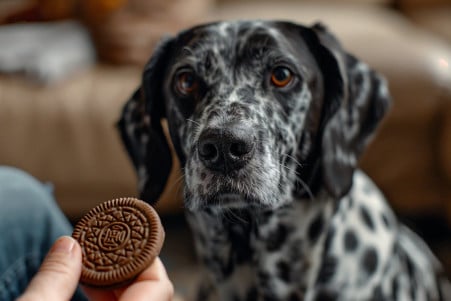Can Dogs Have Cookies? The Dangers of Feeding Dogs Human Food
7 May 2024 • Updated 7 May 2024

As much as we'd all love to share our favorite cookies with our dogs, it's important to know the risks and benefits of giving dogs cookies. While plain cookies are safe for dogs to eat in small amounts, most cookies are made with ingredients like sugar, chocolate, and other additives that can be bad or even dangerous for dogs.
In addition to covering some healthy cookie options for dogs, this article will mostly cover the science that explains why most cookies are not good treats for dogs. It will discuss research from veterinary nutritionists, toxicologists, and pet food scientists that explores how different cookie ingredients can impact dogs. This information will help you better understand which human foods are safe to share with your dog.
Can dogs eat cookies?
Ingredients in Cookies That Are Toxic to Dogs
There are a number of ingredients in cookies that can be dangerous to dogs. Chocolate is one of the most well-known, and it contains theobromine and caffeine, both of which are toxic to dogs. Ingesting even small amounts of chocolate can lead to vomiting, diarrhea, hyperactivity, abnormal heart rhythm, seizures, and in the most serious cases, death, according to the ASPCA Animal Poison Control Center.
Raisins and grapes are another example of a cookie ingredient that can be extremely toxic to dogs. These fruits can cause kidney failure in dogs, and a study in the journal Veterinary Medicine: Research and Reports showed that as little as 0.2 ounces of raisins per kilogram of body weight can lead to acute kidney injury. Macadamia nuts, which are often found in white chocolate cookies, can cause dogs to experience weakness, vomiting, tremors, and hyperthermia and even a small number of nuts can be dangerous.
The artificial sweetener xylitol, which is sometimes used in cookies, is also extremely dangerous for dogs and can lead to a rapid decrease in blood sugar, liver damage, and liver disease that can be fatal. Other ingredients to watch out for include nutmeg, which can lead to seizures, and high levels of sugar, fat, and salt, which can lead to obesity, dental problems, and other health issues. It’s important to check labels carefully to make sure that you’re not inadvertently exposing your dog to any of these harmful ingredients.
Healthy and Safe Homemade Dog Treat Recipes
If you're looking to avoid store-bought treats, making your own at home is a great way to ensure that your dog is getting safe and healthy ingredients. Some common ingredients in homemade dog treats are whole wheat flour, peanut butter, eggs, pumpkin puree, unsweetened applesauce, and cinnamon. Many recipes also include other healthy ingredients like ground flaxseed for skin and coat health, parsley for antioxidants, and turmeric for its anti-inflammatory properties.
Making your own treats also allows you to adjust the recipe to your dog's specific dietary needs or preferences, like using different flours or nut butters. You can also refrigerate or freeze homemade treats to make them last longer and make it easier to control portion sizes.
Nutritious Human Foods for Dogs
While cookies are not a good idea, there are plenty of nutritious human foods that can be added to a dog's diet in moderation. Lean proteins such as cooked chicken, turkey, and fish are great protein sources for dogs and can be used as treats or toppers for their meals. Fresh fruits such as blueberries, apples, and bananas can give dogs vitamins, antioxidants, and fiber, but they should be given in small amounts because they are high in sugar.
Vegetables such as carrots, green beans, and sweet potatoes are healthy choices that can be given to dogs raw or cooked as a crunchy snack. Other human foods that are safe for dogs to eat include peanut butter (as long as it doesn't contain xylitol), plain yogurt, eggs, and cooked oatmeal or quinoa.
How to Introduce New Foods to Dogs: Gradually
As with any new food, it's important to introduce it to your dog slowly and with caution to avoid digestive issues or allergic reactions. Per PetMD, this means starting with a small amount of the new food mixed in with your dog's regular food and gradually increasing the amount over the course of 1-2 weeks. This will give your dog's digestive system time to adapt.
Throughout this process, it's important to keep a close eye on your dog for any signs of issues, including vomiting, diarrhea, itching, or skin rashes. Per the VetDERM Clinic, even a small amount of a potential allergen can cause a reaction after it's ingested. If you notice any of these symptoms, stop giving your dog the new food immediately and contact your vet.
Per Dogs Naturally Magazine, other signs of food allergies in dogs include chronic ear infections, red or brown nails, skin rashes, and watery eyes. It's important to be patient and consistent when introducing a new food, as some dogs may take longer to adjust than others.
Everything in Moderation: How to Safely Give Your Dog Treats
While many human foods are safe for dogs to eat, it’s important to remember that moderation is key. The American Kennel Club notes that this includes both store-bought and homemade dog treats, as well as human foods that are safe for dogs. In fact, no more than 10% of a dog’s daily caloric intake should come from treats. Over time, overfeeding treats can lead to obesity, which can cause a number of health issues in dogs, including joint problems, diabetes, and respiratory issues.
To make sure you’re giving your dog the right amount of treats, experts suggest taking into account your dog’s weight, age, activity level, and any health issues they may have. If you’re unsure, it’s always best to talk to your vet, especially if your dog has dietary restrictions or needs. Your vet can help you determine how many treats your dog can have and how often they can have them.
Conclusion: How to Keep Your Dog Safe and Healthy
While most cookies are not safe for dogs due to the ingredients that are often used to make them, there are some alternatives and human foods that can be given to dogs in moderation.
Homemade dog treats that are made with simple, dog-friendly ingredients like whole wheat flour, peanut butter, and pumpkin puree can be a great option for a healthy and nutritious treat. Fresh fruits, vegetables, lean proteins, and whole grains can also be given as treats or toppers, and they can add some much-needed variety and nutrition to your dog's diet.
As with any new food, it's important to introduce it to your dog slowly and watch for any signs of an adverse reaction or allergy. It's also important to talk to your vet and make sure that you're feeding your dog the right portion sizes to ensure that you're keeping them healthy and safe while still giving them a treat.


